The Mulch - Summer 2008
 For Peat’s Sake For Peat’s Sake
The horticultural industry has been promoting and selling alternatives to peat for some years now and I suppose I had assumed that, because the message about the need to preserve our ever-diminishing peat bogs had got through, I didn’t have to continue to specify peat-alternative compost materials when ordering locally.
So I was more than a little surprised to receive Irish sphagnum peat-based compost in a delivery from a local retailer recently (I had expected a peat-alternative product as the person on the telephone didn’t mention peat to me).
This prompted me to investigate a little further to find out what the current situation actually is, as far as promoting and selling peat is concerned.
The government has set a target to increase the use of alternative growing media in our gardens to 90% of sales by 2010. DEFRA, together with the Horticultural Trades Association (HTA), green groups and other horticultural organisations, are running the Growing Media Initiative to encourage garden centres and garden retail organisations to reduce the sourcing, production and sale of peat-based products to the general public to try to meet the target. Many believe the target won’t be met.
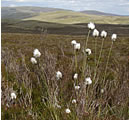 |
^ Bog Standard
Cotton Grass (Eriophorum angustifolium) or Bog Cotton is a familiar sight in summer months on upland peat bogs and acid wetlands of Wales and Northern Britain
|
Figures from DEFRA seem to confirm this view as the amount of peat used in horticulture has remained largely unchanged since 2000, despite efforts to promote alternative composts and soils.
It seems that gardeners, who consume two-thirds of the peat used in the UK, are still reluctant to use peat alternatives even though our use of peat in the garden is a fairly recent habit – peat only became popular in the 1950s after an aggressive marketing campaign by the peat industry. For climatologists, naturalists, historians and archaeologists, our peat bogs contain an unparalleled record of our past and are an unique habitat. It is sobering to be reminded that peat used to cover 95,000 hectares of land in the UK but now only 6% of that remains.
What can we, as gardeners and garden designers do to help? We can help by buying non-peat growing media; press local suppliers to sign up to the HTA Initiative; inform our clients about alternatives and keep specifying non-peat growing media.
For more information: www.the-hta.org.uk/gmi
Sowing Seeds, Seeing Stars
Intrigued about the results from bio-gardening experiments from convinced clients and friends, I decided to have a go at gardening by the phases of the moon this spring.
During April, I sowed some ‘Gardeners’ Delight’ tomato seeds. One tray was sown at the ‘correct’ time and the other at a random (but ‘incorrect’) time.
Tomatoes are Fruit-Seed types that correspond to the element ‘Fire’ and so I sowed the right hand tray (in picture below) on a Fire day (when the moon was in Leo, a fire sign), during a waxing moon phase.
The left hand tray of tomatoes was sown six days earlier on an Earth day (best for Root crops). Both trays received the same amount of light and warmth during germination.
Take a look at the results below. The seeds sown at the ‘wrong’ time germinated poorly with some erratic early growth whilst the seedlings in the right hand tray appear to be healthier and more advanced, even though they are six days younger.
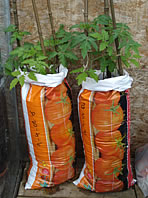
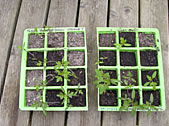 Moon Struck > Moon Struck >
Sowing the same packet of seeds at different times of the moon’s cycle appears to have had an effect on the germination process of these tomato seedlings
|
I have now planted up three seedlings from each of the sowings (see right hand picture below) and you can seer that the plants sown at the ‘right’ time, in the right hand growbag, have continued to grow more strongly. I’ll report back in the autumn!
For more information: www.biodynamic.org.uk
By George!
I was thrilled to receive my first garden design commission around a Georgian rectory this spring. Since then, I have been reading up on that period in garden history to help me understand the design principles in the house and how they relate to the garden space.
I managed to obtain a copy of ‘Georgian Gardens’ from the author Dr David C. Stuart recently. It’s a great read and describes the major works of all the key players of the period from William Kent to Capability Brown and Humphrey Repton. Stuart has created a full and fascinating description of garden development in Britain from 1730 to 1830, crammed with loads of little known facts. www.david-stuart.co.uk/georga.html
Taking Turns
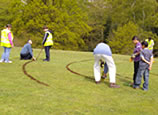 |
^ Feeling groovy
Volunteers at Mayfield Park mark out the new 25 sq. m. turf labyrinth at their Open Day in April
|
Through the spring and early summer, friends groups and supporters of local parks across Southampton were busy running rings around their green spaces – all to provide quiet paths, in the form of the ancient labyrinth symbol, for local park users and visitors to enjoy throughout the summer months.
More than 40 people helped to create the new grass labyrinth in Mayfield Park as part of the park Open Day activities in April. The labyrinth is located next to the obelisk off Weston Road.
And 30 people, including local scouts, helped to create mini-labyrinths in Mansel Park in May ahead of a larger labyrinth planned for midsummer. Go to:
www.thegrowingcompany.co.uk/local_labyrinths for further information.
The Last Post?
I don’t know about you but have you noticed how much stronger the wind seems to blow these days round these parts? And how flimsy appear some of the fencing products currently available?
Even in the sheltered suburbs of Southampton, I’ve worked in gardens where reasonably new fencing has been blown over by freak gusts and funnelled winds (see picture below from a Woolston garden recently).
Is it time we took a critical eye at the way we treat our boundaries? Is it the fault of the fencing or do we need to revisit the way we design along boundaries?
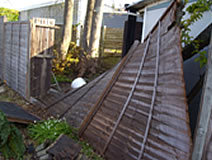 |
^ Final Lap
A poorly erected structure combined with an exposed position reduces the life of a wooden boundary fence. |
In a Dorchester garden recently I suggested that the boundary running alongside the street shouldn’t be screened using a continuous line of 6’ high fencing as it would make an already narrow garden appear much narrower. Instead, I proposed a series of ‘fins’ (fencing panels angled at 90 degrees to the boundary line) at key distances with evergreen hedging on a raised bank along part of the boundary line to give privacy and security in all the desired places without creating a feeling of being hemmed in.
These screening solutions were surprising to my clients as they go against conventional thinking, but will be just as effective as a long line of fencing – and far more harmonious on the eye.
Cuttings…
Pots Stops
Fairweather’s Garden Centre in the High Street, Beaulieu, are accepting old plant pots for recycling. They ask that they are reasonably clean before dropping them off. Phone 01590 612307 for further information. Mayfield Nursery off Weston Lane, Southampton are also accepting larger (5ltr+) pots. Phone 023 8044 7743 for directions.
Ropewalk Garden Community Festival
The annual Community Festival and Fun Day will take place on Saturday 30th August from 12 – 4pm. For more information: ropewalkgarden@btik.com
A Spot of Trouble
The Harlequin Ladybird (Harmonia axyridis) has reached Scotland. Arriving in southern England in 2004, it has spread rapidly northwards causing serious concern for conservationists and entomologists. “This ladybird can have a devastating effect on our native ladybirds.” To join in the Harlequin Ladybird Survey, go to: www.harlequin-survey.org and www.buglife.org.uk
Horse Chestnuts conquered
Bleeding canker disease, caused by the Pseudomonas syringae bacteria, may have affected half of Britain’s Horse Chestnut trees, according to a survey by the Forestry Commission this spring. The bacterium kills the bark of the tree creating a sore which can eventually kill the tree. Symptoms were most common in trees surveyed in south east England (where 76% of horse chestnuts are believed to be affected). www.forestry.gov.uk/fr/INFD-6KYBGV
Farmers in the Frame
Formerly known as Farmers’ Market Month, the annual summer event dedicated to the celebration of British local food produce is now called ‘The Month of Taste’. Organised by FARMA, the largest cooperative of farmers selling direct to the public, you can get involved in tastings, farm tours, demonstrations and picnics to the end of July. For more information, visit: www.monthoftaste.info
Healing Hospital Haven
Frimley Park Hospital is one of 20 trusts nationwide to win a bid worth £30,000 as part of the Department of Health and King’s Fund programme for improving care environments for patients at the end of life. The winning project aims to create a secluded garden for quiet contemplation and privacy.
www.kingsfund.org.uk
And some website news…
A set of before and after photographs of some of my gardens has been uploaded under the Designer page. New pictures on the Community > Labyrinths page, too.
Mark Rendell
garden designer
____________________________________________________________
Imaginative and affordable design
and planting solutions for every kind of garden
www.thegrowingcompany.co.uk
printed printed version uses conservation grade recycled paper
|


